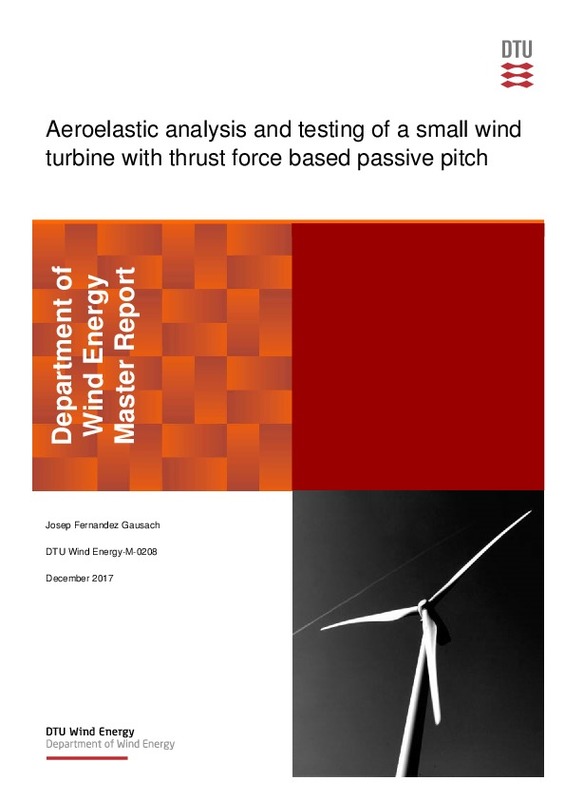|
Resumen:
|
[ES] En esta tesis, un nuevo concepto de pitch, o control de paso de pala, pasivo basado en la fuerza de empuje, concebido por enbreeze GmbH es analizado adaptándolo a una pequeña turbina eólica, y puesta a prueba simulando ...[+]
[ES] En esta tesis, un nuevo concepto de pitch, o control de paso de pala, pasivo basado en la fuerza de empuje, concebido por enbreeze GmbH es analizado adaptándolo a una pequeña turbina eólica, y puesta a prueba simulando el modelo con HAWC2 y construyendo un prototipo real para ponerlo a prueba en el campo.
Esta memoria introduce el concepto estudiado. Se describen los pasos seguidos para realizar la prueba en campo, explicando el prototipo diseñado, el equipamiento usado, y como se ha configurado. Se ha usado un sensor óptico para medir el paso y la velocidad angular en paralelo. El sensor óptico y el anemómetro se han controlado con un microcontrolador Arduino. Se exponen los posibles modos de controlar un generador síncrono de imanes permanentes (PMSG), así como cómo el PMSG usado en este estudio se ha controlado con una carga electrónica y LabVIEW. Para mejorar y facilitar la visualización de los datos adquiridos, se presenta una herramienta de post-procesado que lee los datos en bruto, los mejora, y los hace compatibles con Pdap. Se diseña un sensor de momento flector para la base de la pala, y se explica el proceso de instalación de galgas extensiométricas en un sensor de empuje y par.
El aerogenerador se ha testeado en la salida de un túnel de viento antes de ponerlo a prueba en el campo. Se demuestra que la salida del túnel de viento no es una fuente de viento fiable. También se explica cómo se corrige el espectro de un anemómetro para mostrar los valores correctos de turbulencia. Las pruebas en campo se han llevado a cabo en el campo de pruebas de Risø. Los resultados presentados prueban el correcto funcionamiento del sistema de pitch pasivo sin el uso de muelles o amortiguadores. También se analiza un fallo por fatiga ocurrido durante el test.
Se ha implementado en HAWC2 un modelo de la turbina eólica con pitch pasivo. HAWC2 es un software de modelado aero-hidro-servo-elástico que permite simular el comportamiento real de aerogeneradores. Para validar el modelo en HAWC2, se han recreado las condiciones medidas en campo y se ha comparado el modelo numérico con el prototipo real. También se ha llevado a cabo una comparación de la pequeña turbina eólica usada en este proyecto con la turbina de 15kW de enbreeze equipada con el mismo sistema de pitch pasivo.
Finalmente, el comportamiento de la turbina de 15kW se analiza sin el uso de amortiguador en el sistema de pitch pasivo, que se utiliza para mitigar una inestabilidad aeroelástica. Se concluye que la oscilación de la torre no causa esta inestabilidad, y se proponen dos alternativas para mitigar este efecto: equipar el controlador del generador con un PID, y usar investigación operativa para optimizar los parámetros del acoplamiento mecánico del sistema de pitch pasivo.
[-]
[EN] In this thesis, a new passive pitch concept based on the thrust force conceived by enbreeze GmbH is analyzed by adapting it to a small wind turbine, and testing it both simulating the model with HAWC2, and building a ...[+]
[EN] In this thesis, a new passive pitch concept based on the thrust force conceived by enbreeze GmbH is analyzed by adapting it to a small wind turbine, and testing it both simulating the model with HAWC2, and building a real prototype for testing it on field.
This report introduces the studied concept. The steps followed to realize the field test are described, explaining designed prototype, the equipment used, and how it has been configured. An optical sensor has been used to measure pitch angle and rotational speed in parallel. The optical sensor and an anemometer have been controlled with an Arduino microcontroller. The possible ways of controlling a permanent magnet synchronous generator (PMSG) are exposed, as well as how the PMSG used in the present study has been controlled using an electronic load and LabVIEW. To enhance and ease the visualization of the acquired data, it is presented a post-processing tool that reads the raw data, enhances and makes it readable by Pdap. It is designed a bending moment sensor for the blade root, and explained the process of attaching strain gages on a thrust-torque sensor.
The wind turbine has been tested in a wind tunnel output before testing it in the field. It is demonstrated that the wind tunnel output is not a reliable wind source. It is also explained how to correct the spectrum of an anemometer to show the right values of turbulence. The field test has been carried out in the Risø test field. The presented results prove the correct performance of the passive pitch system without the use of springs or dampers. It is analyzed a fatigue failure happened during the test.
A model of the wind turbine with the passive pitch system has been implemented in HAWC2. HAWC2 is an aero-hydro-servo-elastic modelling software that allows to simulate the real behavior of the wind turbine. In order to validate the HAWC2 model, the conditions measured in the field test have been recreated, and compared the numerical model with the real prototype. It is also carried out a comparison of the small wind turbine used in this project with the 15kW enbreeze wind turbine, equipped with the same passive pitch system.
Finally, the behavior of the 15kW enbreeze wind turbine is analyzed without the use of a damper on the passive pitch system, which is used at the present to mitigate an instability. It is concluded that the tower oscillation is not causing this instability, and two alternative ways for mitigating this problem are proposed: to equip the generator controller with a PID, and using operations research to optimize the parameters of the passive pitch system linkages.
[-]
|







